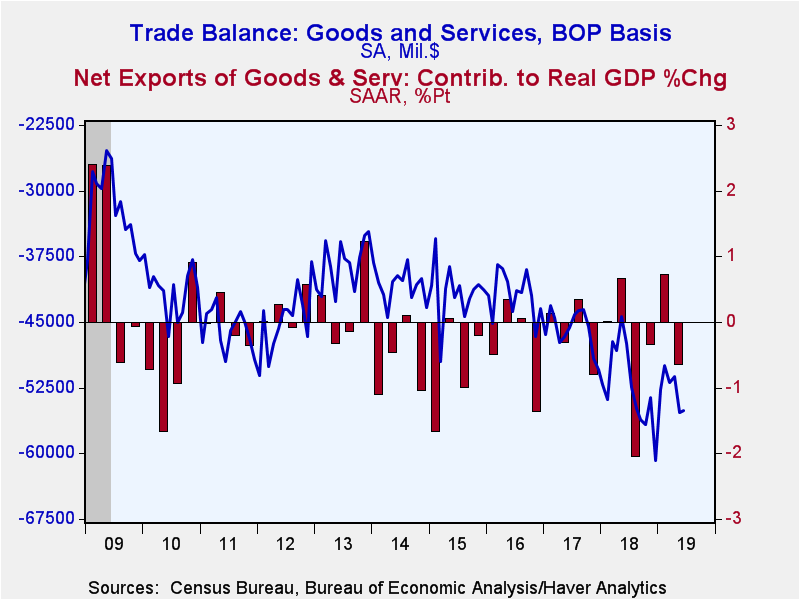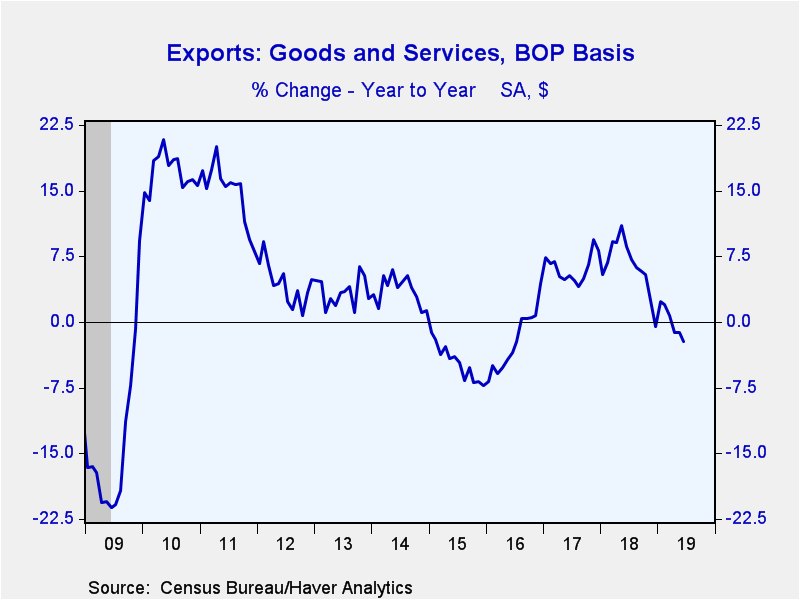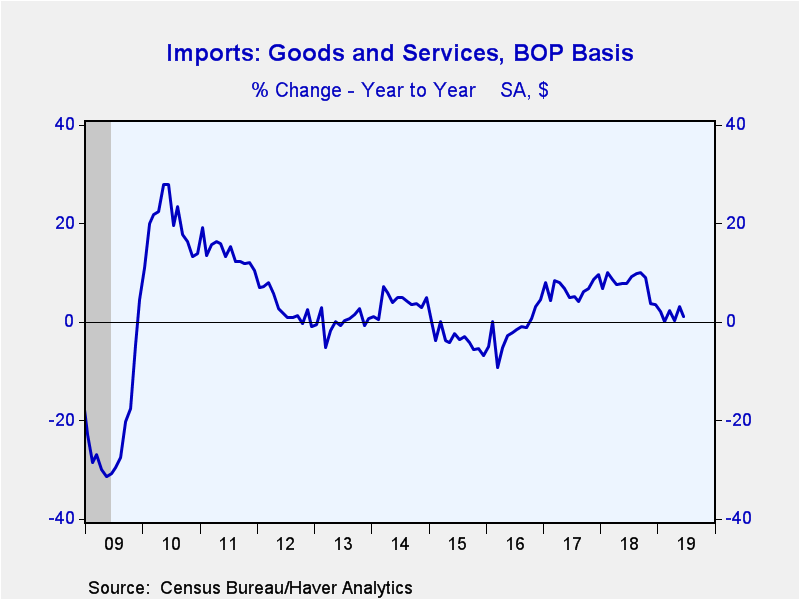 Global| Aug 02 2019
Global| Aug 02 2019U.S. Trade Deficit Narrowed Slightly in June
Summary
The U.S. trade deficit in goods and services decreased ever so slightly in June to $55.2 billion from May's $55.3 billion; that month's result was revised marginally from $55.5 billion. The consensus expectation from the Action [...]
The U.S. trade deficit in goods and services decreased ever so slightly in June to $55.2 billion from May's $55.3 billion; that month's result was revised marginally from $55.5 billion. The consensus expectation from the Action Economics Survey was a $54.5 billion deficit. The slight $0.2 billion narrowing of the overall trade deficit corresponded to a $0.4 billion narrowing of the goods deficit reported in the advance data on July 25. Both exports and imports of goods and services decreased in June. Total exports fell 2.1% (-2.2% y/y), reversing a similar 2.1% increase in May, which was modestly revised from 2.2%. Imports declined 1.7% in June (+1.2% y/y) after May's 3.3% rise. The goods deficit narrowed to $75.2 billion in June from May's $75.9 billion. The surplus in services narrowed to $20.0 billion from $20.55 billion the month before. Year to date, the goods and services deficit totaled $316.3 billion through June, compared to $293.1 billion in the first half of 2018.
Goods exports fell 2.7% m/m in June (-3.6% y/y), basically reversing May's 3.1% increase. The reversal took place across a number of end-use categories: consumer goods excluding food and autos fell 10.7% after May's 4.7% increase. Auto exports fell 3.7% after also gaining 4.7% in May. Capital goods declined 2.6% after rising 3.0% in May, and “other” goods dropped 7.1% after May's surge of 17.0%. Food & beverage and industrial supplies shipments both showed modest increases in June.
Imports of goods decreased 2.1% m/m in June (+0.3% y/y), offsetting about half of the relatively sizable May rise of 3.9%. All the end-use categories saw declines except “other,” which actually surged for a second month, rising 7.4% after May's 11.6%. Among the other line-items, industrial supplies had the biggest decrease, 6.9%, more than reversing their May 3.9% rise. Autos fell back 1.8% after May's 7.5% increase and consumer goods fell 1.6% after May's 2.5% increase.
Petroleum imports dropped13.9% in June after four consecutive monthly increases. After adjusting for changes in petroleum prices, real petroleum imports fell 8.8% m/m in June, reversing May's 8.6% advance. The price of crude oil imports eased 2.3% to $59.18 per barrel after four consecutive monthly increases. The June price is still the second highest since last October. Non-petroleum imports eased 0.9% after May's 3.4% rise.
Services exports decreased 0.7% in June (+0.5& y/y) following a 0.3% rise in May. The June reduction was fairly mixed by category, with the decreases in travel, transport, finance, insurance and intellectual property. There were increases in maintenance services, telecommunications, “other business” and government services. Services imports rose 0.2% in June (+5.1% y/y) after a 0.3% increase in May. Every category except transport and maintenance experienced a small 0.1-0.2% increase. Maintenance services actually saw a 3.3% gain, while transport service imports fell 0.1%.
The seasonally adjusted trade deficit in goods with China was basically unchanged in June, at $30.2 billion after May's $30.1 billion. June's imports were $39.75 billion after $39.85 billion in May. These compare to a monthly average of $45 billion during all of 2018. Goods exports to China were $9.6 billion in June, down from $9.8 billion in May; the monthly average for 2018 was $10.0 billion.
The international trade data, including relevant data on oil prices, can be found in Haver's USECON database. Detailed figures on international trade are available in the USINT database. The expectations figures are from the Action Economics Forecast Survey, which is carried in AS1REPNA.
| Foreign Trade in Goods & Services (Current $) | Jun | May | Apr | Jun Y/Y | 2018 | 2017 | 2016 |
|---|---|---|---|---|---|---|---|
| U.S. Trade Deficit ($ bil.) | 55.2 | 55.3 | 51.2 | 47.4 (6/18) |
627.7 | 550.1 | 503.0 |
| Exports of Goods & Services (% Chg) | -2.1 | 2.1 | -2.4 | -2.2 | 6.3 | 6.2 | -2.2 |
| Imports of Goods & Services (% Chg) | -1.7 | 3.3 | -2.2 | 1.2 | 7.8 | 6.8 | -1.7 |
| Petroleum (% Chg) | -13.9 | 9.0 | 4.2 | -14.6 | 20.8 | 27.2 | -19.5 |
| Nonpetroleum Goods (% Chg) | -0.9 | 3.4 | -3.1 | 1.8 | 7.5 | 5.5 | -1.2 |
Carol Stone, CBE
AuthorMore in Author Profile »Carol Stone, CBE came to Haver Analytics in 2003 following more than 35 years as a financial market economist at major Wall Street financial institutions, most especially Merrill Lynch and Nomura Securities. She has broad experience in analysis and forecasting of flow-of-funds accounts, the federal budget and Federal Reserve operations. At Nomura Securites, among other duties, she developed various indicator forecasting tools and edited a daily global publication produced in London and New York for readers in Tokyo. At Haver Analytics, Carol is a member of the Research Department, aiding database managers with research and documentation efforts, as well as posting commentary on select economic reports. In addition, she conducts Ways-of-the-World, a blog on economic issues for an Episcopal-Church-affiliated website, The Geranium Farm. During her career, Carol served as an officer of the Money Marketeers and the Downtown Economists Club. She has a PhD from NYU's Stern School of Business. She lives in Brooklyn, New York, and has a weekend home on Long Island.









